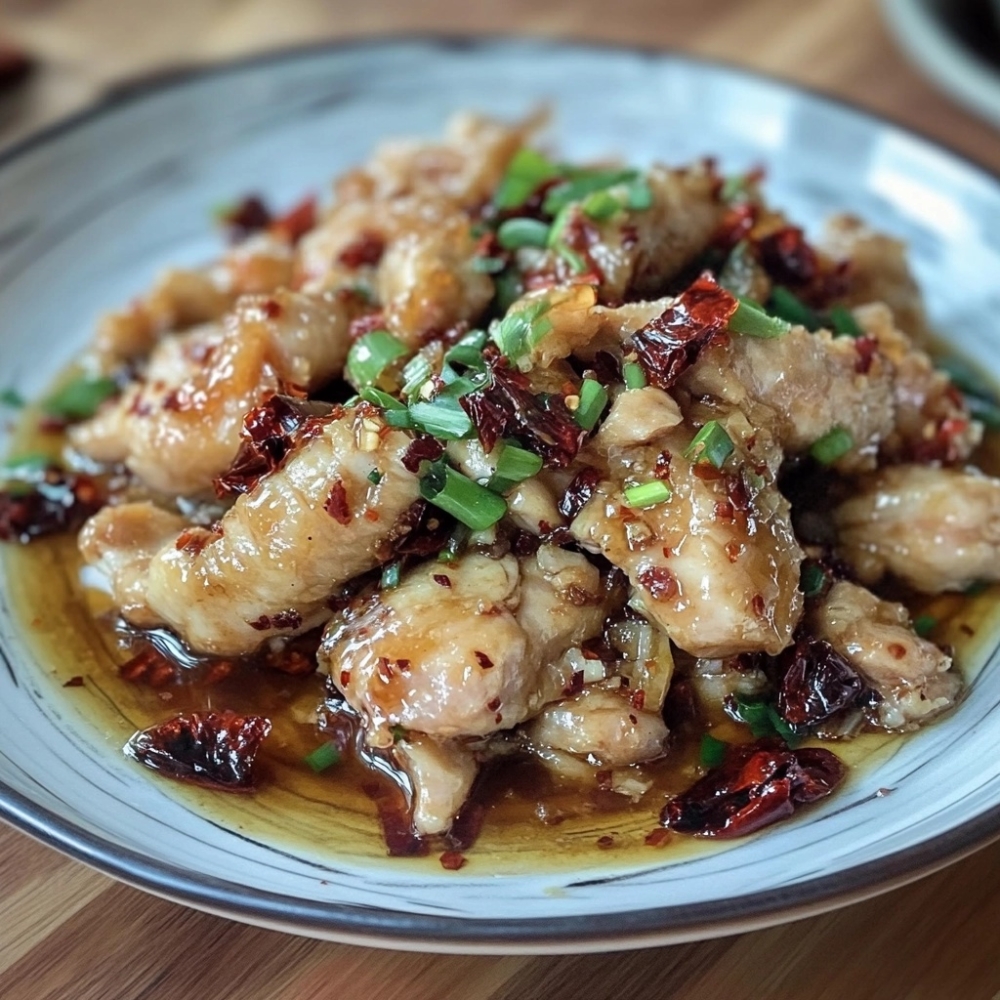Kou Shui Ji, also known as Sichuan Mouthwatering Chicken, is one of the most beloved cold chicken dishes in Chinese cuisine. Originating from the Sichuan province, it combines poached chicken with a bold, spicy, and fragrant sauce that is layered with complex flavors—numbing Sichuan peppercorns, chili oil, garlic, soy sauce, and black vinegar.
Despite the name, this dish is served cold or at room temperature, making it ideal for hot weather or as a striking appetizer. The name “kou shui ji” translates to “saliva chicken” because the aroma and flavor are so enticing, it is said to make your mouth water instantly.
This dish is surprisingly easy to recreate at home with just a few key ingredients and some attention to detail. Here is how you can make an authentic version in your own kitchen.
Ingredients for Kou Shui Ji
For the Chicken
- One whole chicken (about three to four pounds) or four bone-in skin-on chicken thighs
- Two slices fresh ginger
- Two scallions, cut into large pieces
- One tablespoon Chinese cooking wine or dry sherry
- Cold water, enough to fully submerge the chicken
For the Sauce
- Three tablespoons chili oil (preferably homemade or Lao Gan Ma brand)
- One tablespoon soy sauce
- One tablespoon light soy sauce
- One and a half teaspoons Chinkiang black vinegar
- One tablespoon sesame oil
- One teaspoon sugar
- One tablespoon garlic, finely minced
- One teaspoon toasted Sichuan peppercorns, ground
- One teaspoon ginger, finely grated
- One tablespoon roasted peanuts or sesame seeds (optional for garnish)
- One scallion, finely chopped (for garnish)
- Fresh cilantro for garnish (optional)
Preparation Time
- Chicken preparation and cooking: 45 minutes
- Sauce preparation: 10 minutes
- Cooling and resting time: 30 minutes
- Total time: Approximately 1 hour and 30 minutes
Step-by-Step Instructions
Step 1: Prepare and Cook the Chicken
- Place the whole chicken or chicken thighs in a large pot and cover with cold water.
- Add the ginger slices, scallions, and cooking wine to the pot.
- Bring to a gentle boil over medium-high heat, then reduce to low and simmer.
- Cook the chicken for 25 to 30 minutes until fully cooked through but still tender. Do not overboil.
- Remove the chicken from the pot and immediately place it in a large bowl of ice water. Let it sit for at least 15 minutes. This step firms up the skin and locks in the juices.
Step 2: Cut and Arrange the Chicken
- Once cooled, remove the chicken and pat dry with paper towels.
- Use a cleaver or sharp knife to cut the chicken into bite-sized pieces, keeping the skin intact.
- Arrange the pieces neatly on a serving plate. If using boneless chicken, you may slice it instead of chopping.
Step 3: Prepare the Sauce
- In a bowl, combine chili oil, soy sauce, light soy sauce, black vinegar, sesame oil, and sugar.
- Add the minced garlic, grated ginger, and ground Sichuan peppercorns.
- Whisk the sauce together until the sugar dissolves and all ingredients are well combined.
- Taste and adjust for balance. You may add more vinegar for brightness or chili oil for heat.
Step 4: Assemble and Garnish
- Pour the sauce generously over the cut chicken, making sure it coats all pieces.
- Let the chicken sit in the sauce for at least 15 minutes to absorb the flavors.
- Sprinkle with chopped scallions, roasted peanuts or sesame seeds, and fresh cilantro, if desired.
- Serve chilled or at room temperature as an appetizer or a main dish with rice.
Serving Suggestions
- Serve Kou Shui Ji alongside steamed jasmine rice or chilled noodles.
- Pair with lightly stir-fried vegetables or pickled cucumbers for a balanced meal.
- This dish works well as a cold starter before heavier main courses.
- For a dinner party, serve in a shallow platter with extra sauce on the side for dipping.
Variations and Tips
- Use boneless chicken breasts for a leaner version, though bone-in thighs or whole chicken offer more flavor.
- For deeper flavor, marinate the cooked chicken in the sauce for one to two hours in the refrigerator before serving.
- Add a teaspoon of crushed peanuts or toasted sesame seeds to the sauce for a nutty dimension.
- Adjust the chili oil and Sichuan peppercorn levels to suit your preferred heat and numbing levels.
Common Mistakes to Avoid
- Do not boil the chicken too rapidly. A gentle simmer ensures tender meat and clear broth.
- Do not skip the ice bath. It helps create the signature smooth skin texture and prevents overcooking.
- Avoid using bottled chili oil without checking its flavor. A good-quality chili oil will elevate the entire dish.
- Do not oversalt the sauce. Remember that soy sauce and chili oil may already contain salt. Taste before adjusting.
Storage Tips
- Store leftover Kou Shui Ji in an airtight container in the refrigerator for up to three days.
- For best flavor, let the chicken come to room temperature before serving leftovers.
- Do not freeze this dish, as the texture of both the chicken and the sauce will be compromised upon thawing.
Kou Shui Ji is a testament to the depth and artistry of Sichuan cuisine. The contrast of cold, tender chicken with hot, numbing, and savory sauce creates a multi-dimensional experience that truly lives up to its name. Once you master this dish, it will become a staple in your rotation for both everyday meals and special gatherings.
Try it once and you will understand why Kou Shui Ji is one of the most popular cold chicken dishes in China. It is bold, flavorful, and surprisingly simple to make at home with the right ingredients and a bit of patience.

